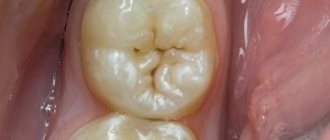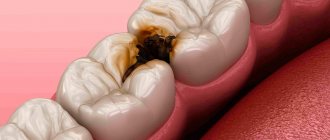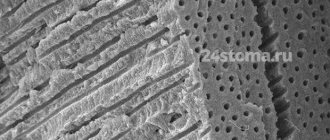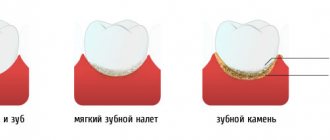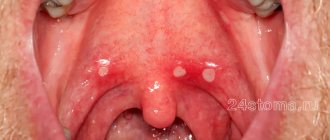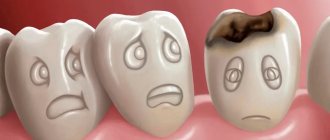Author of the article:
Soldatova Lyudmila Nikolaevna
Candidate of Medical Sciences, Professor of the Department of Clinical Dentistry of the St. Petersburg Medical and Social Institute, Chief Physician of the Alfa-Dent Dental Clinic, St. Petersburg
Dentists are often approached with such a problem as pain in the front teeth. There is nothing surprising. After all, although all our teeth have more or less the same internal structure, it is the incisors, due to their location, that are often subject to mechanical injuries.
In addition, our front teeth are distinguished by a thin layer of dentin (the bone tissue that makes up the bulk of the tooth). Because of this, caries on the incisors develops much faster than on other teeth.
Differences from adult pulpitis
Pulpitis
The structure of baby teeth is different from permanent teeth. They have practically no roots, very thin enamel and large pulp. Because of this, caries flows into pulpitis much more easily and quickly - it needs to overcome a very small barrier to the dental nerve.
At the same time, the baby teeth themselves are smaller in size than the molars, and this complicates treatment - there is a high risk of damaging the pulp chamber, and cleaning the canals is very problematic.
At the same time, childhood pulpitis is characterized by a very rapid transition to a chronic form. That is, severe pain does not last long and then goes away, but the tooth remains painful and can get sick again, provoke inflammation of neighboring teeth, or even cause destruction of the permanent tooth germ.
All these features interfere with diagnosis and treatment, so it is important that this is done by a pediatric dentist who is familiar with the specifics of pulpitis of primary teeth. An adult doctor usually does not have enough experience and skills to treat.
Causes of pulpitis in children
Pulpitis in children
The causes of pulpitis in children are basically the same as in adults.
Untreated caries in time. Under the influence of caries, the tooth is gradually destroyed, and bacteria sooner or later penetrate into the pulp, causing its inflammation. Since the enamel and dentin of baby teeth are very thin, caries can sometimes develop into pulpitis in a few months or even weeks, that is, very quickly. In addition, the situation is complicated by the fact that parents often do not pay attention to childhood caries, since “the teeth will soon fall out anyway.”
Injury to a baby tooth. This often happens during play - the child hits his face and the teeth seem to be intact, but in fact the root or pulp is damaged. As a result, due to trauma, pulpitis can develop even in a tooth that outwardly appears completely healthy.
Medical error in the treatment of caries. Since a child's pulp is very close to the surface of the tooth, during normal caries it is easy to accidentally damage the tissue and open the pulp chamber. And even if there is no injury, the pulp can become inflamed simply due to exposure to the filling material, too strong an antiseptic, and even overheating during treatment. Most often, this happens when a child is treated by an inexperienced dentist or an “adult” doctor who is not accustomed to working with baby teeth.
Acute infection. Sometimes bacteria penetrate the pulp not from the outside, but from the inside, through the blood. This happens if a child suddenly gets sick with something, for example, a sore throat. Such “internal” pulpitis is rare, but you need to be aware of its possibility in order to connect a recent illness and toothache in time.
Symptoms of pulpitis of baby teeth
The following symptoms are characteristic of childhood pulpitis.
Strong pain. Most often it occurs in the evening and at night, or during chewing and pressure. In addition, the child may refuse to eat hot or cold food or complain of pain outside in the cold.
There is one problem with this symptom - due to the rapid transition of pulpitis into chronic pain, the pain can go away in just a couple of days, so sometimes the child simply does not have time to complain, and the parents do not have time to react.
In addition, if pain bothers a very young child, he often cannot clearly explain what is wrong, so you need to focus on external signs - crying, moodiness, refusal to eat.
A noticeable carious cavity on a tooth . This is not a mandatory sign - sometimes the tooth is externally intact, but the pulp in it is inflamed. However, if a child complains of pain or feels unwell, and one or more teeth are damaged, this is a sign of pulpitis.
Loosening of the tooth. Due to injury or destruction of the pulp, the tooth may begin to become loose, although it is too early for it to fall out.
Increase in temperature and deterioration in general health . It is especially common in young children, as they react particularly acutely to inflammation.
Swelling or swelling of the cheek. It doesn't happen very often, but it is a clear sign that something is wrong with your teeth. This can be a symptom of both pulpitis and periodontitis or periostitis - a doctor will make an accurate diagnosis.
All these symptoms are weak and unexpressed, sometimes even the child himself ignores them. Only a doctor can accurately diagnose pulpitis, and various methods are used for this, from a simple examination to an x-ray. Therefore, it is important, even in childhood, to regularly take your child to the dentist in order to recognize the disease in time.
What to do if a toothache occurs after a visit to the dentist?
Most often, pain after any dental intervention is normal, and if all necessary recommendations are followed, it should stop soon. The doctor should warn the patient that after the procedure there will be slight discomfort.
Painful sensations when pressing on a tooth after installing a filling cannot indicate any disruption in the work of the specialist. Normally, after treatment, a filled tooth will “give off” a slight aching pain for another couple of days.
But if the patient experiences pain for at least a week after any intervention, this fact is a serious reason to consult a doctor again. This phenomenon may indicate that the dentist’s work was done incorrectly. In this case, the specialist must repeat the procedure, but more carefully.
Important! Such pain may be a consequence of improper installation of the filling or insufficient sealing of the filling. Pain may also indicate improper disinfection during the intervention. In this case, there is a risk of infections entering the affected area.
If you have a symptom such as prolonged pain after any procedures, you should immediately consult a doctor again, as this condition can cause severe complications.
At what age does pulpitis occur in children?
Development of pulpitis
Some parents believe that a small child cannot develop caries, not to mention pulpitis. They think that a newly erupted tooth is protected from disease, so they do not examine the child’s mouth or take him to the dentist.
However, children's teeth are actually very susceptible to disease. The risk of developing pulpitis is especially high in cases where the child is often given sweets, but even if you do not overfeed the baby with sugar, his teeth can still get sick.
Even at two years old, pulpitis can affect the front milk teeth. But at 3–4 years of age, caries and pulpitis most often affect the posterior chewing teeth, while the anterior teeth remain virtually unaffected by inflammation.
Why do you need to treat pulpitis of baby teeth?
Often parents believe that baby teeth do not need to be treated at all. If they do not bother you, it is better to simply not touch them, and if they do bother you, remove them, since the tooth will soon fall out anyway. But there are several reasons why treating childhood pulpitis is very important:
- Acute inflammation can spread to the germ of a permanent tooth, and it will immediately erupt into the patient.
- Extracting a tooth too early will lead to malocclusion - baby teeth will move into empty space, and permanent teeth will erupt incorrectly because of this.
- Pain in an untreated tooth can periodically return and greatly ruin a child’s life and interfere with chewing food normally.
- Losing a tooth at an early stage of speech formation can cause serious speech therapy problems - the child will not be able to pronounce individual sounds normally.
For all these reasons, even baby teeth need treatment.
Why do teeth fall out due to gum disease?
If your gums near a tooth hurt, you may soon experience bleeding, swelling and inflammation. If you refuse to take action, the inflammatory process from the gums will spread to the ligament and bone surrounding the tooth. Your teeth will begin to loosen and fall out one by one. And this is not a fictional story from a horror movie, but the real consequences of periodontitis, which is widespread in our time, which is increasingly being diagnosed even in 30-year-old patients.
Treatment of pulpitis in children
There are several ways to cure pulpitis of a baby tooth.
Classic non-vital amputation
This method is now considered outdated, but it is still used in some clinics, especially in free public dentistry. The essence of this method is as follows:
- The doctor drills out the carious tissue, opens the pulp and applies a special paste to it that kills the nerve. Previously, pastes with arsenic were used - they killed the nerve in two days, but were not very beneficial for health. Now they use safer means, but they take a week to kill the nerve.
- When the nerve is killed, a special mixture is pumped into the tooth to mummify the pulp. Sometimes the pulp is partially removed.
- At the last visit, the doctor installs a permanent filling.
In adults, this method is now practically not used, since the tooth turns gray after it, and the pulp can become inflamed. However, when treating baby teeth, the method has the right to be used, since the baby tooth will still quickly fall out, and pulpitis will not have time to reoccur.
The main advantage of this technique is its simplicity and low cost. The treatment can be carried out by almost any dentist, so in rare cases the use of this method is justified. But in order not to expose the child’s body to stress, it is better to use other treatment methods.
Vital pulp extraction
This method exists today thanks to the advent of modern powerful anesthetics. It is most often used to treat pulpitis in adults, and is often used on children.
The essence of the technique is that, under powerful anesthesia, the living pulp is completely removed from all root canals of the tooth. After this, the canals are carefully processed and then filled with a special paste.
In adults, gutta-percha is used for filling, but it does not dissolve over time—in a child’s tooth, this would prevent it from falling out. Therefore, for children, the canals are filled with zinc-eugenol paste, which will gradually dissolve along with the roots.
This method is good, but requires special skill of the doctor, as well as the use of expensive materials and instruments. Therefore, treatment of pulpitis using this method is rarely offered in public clinics, and in paid clinics it can cost several thousand per tooth.
Vital amputation
This is a very rare method, since it is applicable only at the very beginning of the onset of pulpitis. That is, you need to run to the doctor as soon as the child complains of tooth pain - only then will this method be effective.
Its essence lies in the fact that under anesthesia, only the inflamed area of the nerve is removed from the tooth. An antiseptic and anti-inflammatory medicine is applied to the rest of the nerve, and then everything is carefully sealed. This technique allows you to partially preserve the pulp and extend the life of the tooth, but when using it there is a high risk of recurrent pulpitis.
Primary Pain Relievers
To help your child before receiving medical help, and to reduce the severity of the pain, you can use the following methods.
- Painkillers. The active ingredient ibuprofen is suitable for a child, for example, it is sold in the form of Nurofen syrup. Its use is possible for children from the age of three months, and the medicine will begin to act within half an hour.
- Anti-inflammatory drugs. The most commonly used is paracetamol. It not only reduces pain, relieves inflammation, but also helps fight fever. The effect of the drug lasts up to six hours, and the first relief occurs half an hour after administration.
- Antihistamines. Anti-allergenic drugs are aimed at reducing swelling. Zyrtec or Zodac are suitable for children, and in some forms they are available even to newborns.
Prevention of childhood pulpitis
Treating pulpitis in baby teeth is difficult and expensive, so it is best to avoid it. The following preventive measures will help with this:
- Start oral hygiene from the eruption of the very first tooth, and gradually accustom the child to it.
- Brush children's teeth with special toothpastes containing age-appropriate fluoride.
- Avoid giving your child too many sweets, especially sugary drinks. The most dangerous thing is to give a child sweets from a bottle - because of this, the front teeth are often affected by caries, and then pulpitis.
- Make sure your child's diet includes plenty of fresh vegetables and fruits. Solid foods are especially beneficial - they strengthen teeth and help remove plaque.
- Every six months, take your child to the dentist for preventive examinations so that the doctor can notice and treat caries in time.
- At the first signs of even mild dental damage, do not let the process take its course, but take the child to the dentist.
These measures will help you prevent pulpitis and keep your child's baby and permanent teeth healthy.
What to do: treat yourself at home or see a doctor
Many people wonder: if your gums hurt, can it be treated at home? Unfortunately, self-medication will not help, but will only worsen the situation. All that was required of you was to regularly carry out the prevention of periodontal diseases, which would help prevent inflammation. But now it’s too late to prepare decoctions from oak bark and buy another rinse with tea tree extract. These remedies are no longer effective in the rapidly developing inflammatory process. Only timely comprehensive treatment can stop the course of the disease and significantly improve the condition of the gums.
If your gums are inflamed and painful, only a periodontist will help you. He diagnoses and treats periodontal diseases such as gingivitis, periodontitis, and periodontal disease. His professional competence also includes the treatment of stomatitis, glossitis, halitosis and oral candidiasis.
Before starting treatment, the doctor collects anamnesis, determines the hygiene level index, and gives directions for diagnostics and tests. If during the examination some systemic disease of the body is revealed that provoked gum inflammation, in this case the treatment will be carried out under the supervision of several specialists.
Modern methods of treating gum disease are safe and painless. After the first procedure you will notice their effectiveness.
